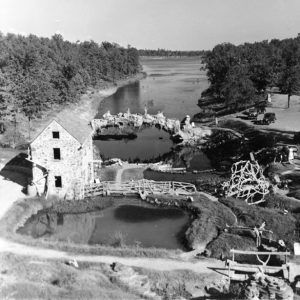calsfoundation@cals.org
Dionicio Rodriguez (1891–1955)
Dionicio Rodriguez, recognized as one of America’s foremost faux bois sculptors, created works that resembled wood, though made of concrete, with its peeling bark, wormholes, and signs of decay. Arkansas was a major beneficiary of his work, which was an outgrowth of a Mexican folk tradition known as el trabajo rustico (rustic work). Under the designation “The Arkansas Sculptures of Dionicio Rodriguez,” his Arkansas work was collectively listed on the National Register of Historic Places on December 4, 1986.
Dionicio Rodriguez was born in Toluca, Mexico, the son of Catarine Rodriguez; his birthdate is a matter of some dispute, usually stated as either April 11, 1891, or April 8, 1893. With little formal education, he began, at the age of fifteen, to work for a foundry in Mexico, and his earliest work can be seen at Chapultepec Castle and the President’s Palace in Mexico City. He later served with an Italian artist, Robles Hill, who produced imitation rocks, caverns, ruins, and ancient buildings. Rodriguez’s move to Laredo, Texas, about 1910 was undoubtedly influenced by the general political unrest in Mexico at the time. After Rodriguez moved to San Antonio, Texas, in the mid-1920s, Dr. Aureliano Urrutia, physician to the president of Mexico, introduced him to Alamo Cement Company, and he worked for them through the late 1920s.
Justin Matthews, developer of the Lakewood community in North Little Rock (Pulaski County), first learned of the sculptor’s work when he visited Mexico City and immediately recognized the sculptor’s, talent. Matthews tracked down Rodriguez in San Antonio and negotiated with him through an interpreter, since the sculptor could neither speak nor write English. By 1932, Rodriguez was creating works for Matthews’s three parks: Lakewood, Crestwood, and the T. R. Pugh Memorial Park. The latter, dedicated in 1933, became a showplace, and filmgoers around the world were treated to a Technicolor view of the Old Mill, a Rodriguez masterpiece, during the musical interlude that accompanied the opening screen credits of the movie Gone with the Wind in 1939. Other Rodriguez-sculpted pieces at the parks included a hollow treehouse, rustic bridge, flower basket, and parasol-form tree. His work in Lakewood has special appeal to the public because the various sculpted pieces are visible and physically accessible to visitors.
About 1940, Harvey C. Couch, then president of Arkansas Power and Light (AP&L), commissioned Rodriguez to create sculptures to enhance Couchwood, his Garland County lodge site, and Little Switzerland, a retreat in Hot Spring County. With its sculpted lodge deck, planters, outdoor seating, and drink cooler (disguised as a tree stump), Couchwood offers the best collection of his work in the domestic sculpture category.
Helpers built concrete footings for his sculptures, and the underpinnings were made with reinforcing bars, rods, mesh screen wire, and rubble, held together with a rough coat of concrete. Metal materials were bound together with wire, not welded. Working outdoors, the sculptor himself applied the surface coat of smooth concrete or “neat” cement, a term for pure Portland cement. To imitate nature, varied textures were created using his hands, forks, spoons, or handmade tools. Secretive about his methodology, the nomadic Rodriguez made no preliminary sketches or drawings and did not record the ingredients of the chemical washes used to tint his sculptures.
Rodriguez worked at various locations throughout the U.S. for more than thirty years, purportedly in Maryland, New Mexico, Washington DC, Alabama, Michigan, Illinois, and Tennessee. A long-ailing diabetic, Rodriguez spent his last days in San Antonio and died there on December 16, 1955. Though rumored to have been married as a young man, he left no immediate heir. He is buried in San Antonio’s San Fernando Archdiocesan Cemetery.
For additional information:
“The Arkansas Sculptures of Dionicio Rodriguez.” National Register of Historic Places nomination form. June 4, 1984. Revised October 1986. On file at Arkansas Historic Preservation Program, Little Rock, Arkansas. Online at https://npgallery.nps.gov/NRHP/GetAsset/NRHP/64000021_text (accessed July 11, 2023).
Cramer, Dayna A. “Cultural Resource Management of Concrete Sculptures and Landscape Features Case Study: Dionicio Rodriguez.” MS thesis, University of Texas at San Antonio, 2017.
Crawford, Sybil F. “Dionicio Rodriguez: The Faux Bois Sculptor.” Pulaski County Historical Review 50 (Spring 2002): 13–24.
Jasper, Pat, and Kay Turner. Art Among Us: Mexican Folk Art of San Antonio. San Antonio: San Antonio Museum Association, 1986.
Light, Patsy Pittman. Capturing Nature: The Cement Sculpture of Dionicio Rodriguez. College Station: Texas A&M Press, 2008.
Sybil F. Crawford
Dallas, Texas







I recently learned of this man, through the fact that he did some work on the Singer Home in Trumann, Arkansas. I have enjoyed learning about this master craftsman, and you will never find work exactly like his again. Truly treasures and art.
My grandparents befriended Dionicio Rodriguez when he was working on the Old Mill in North Little Rock. They also took him in and helped him learn some English. My grandmother passed several years ago, but about thirteen or fourteen years ago someone from North Little Rock came and took a photo of a small concrete Madonna that he had made for my grandmother, Mickey Dutton–which is now in my possession. I also have a few photos of some of the pieces he did. (Him under the mushroom–in Lakewood—as well as my grandmother with his or my grandparents’ car.)